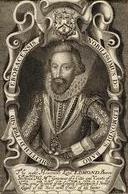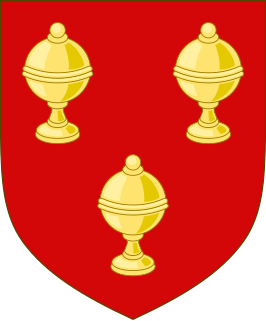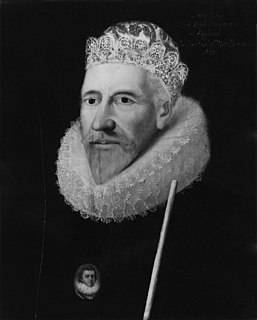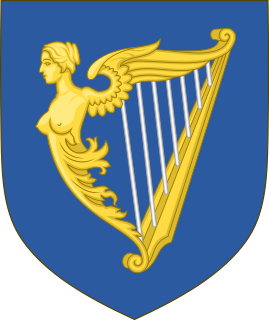
Marquess of Normanby is a title that has been created twice, once in the Peerage of England and once in the Peerage of the United Kingdom. The first creation came in 1694 in the Peerage of England in favour of John Sheffield, 3rd Earl of Mulgrave. He was a notable Tory politician of the late Stuart period, who served under Queen Anne as Lord Privy Seal and Lord President of the Council. In 1703 this first Marquess of Normanby was further honoured when he was made Duke of Buckingham and Normanby. These titles became extinct on the death of the 2nd Duke in 1735.

Viscount Palmerston was a title in the Peerage of Ireland. It was created on 12 March 1723 for Henry Temple, who subsequently represented East Grinstead, Bossiney and Weobley in the British House of Commons. He was made Baron Temple, of Mount Temple in the County of Sligo, at the same time, also in the Peerage of Ireland. He was succeeded by his grandson, the 2nd Viscount, who represented seven constituencies in the House of Commons and served as a Lord of the Admiralty and Lord of the Treasury. On his death the titles passed to his son, the 3rd Viscount, who became a distinguished politician and served three times as Foreign Secretary and twice as Prime Minister of the United Kingdom. At his death in 1865 the 3rd Viscount was granted a state funeral, the fourth non-royal to be given this honour. Lord Palmerston was childless and the barony and viscountcy became extinct on his death.

The title Duke of Abercorn is a title in the Peerage of Ireland. It was created in 1868 and bestowed upon James Hamilton, 2nd Marquess of Abercorn. Although the Dukedom is in the Peerage of Ireland, it refers to Abercorn, West Lothian, and the Duke also bears four titles in Peerage of Scotland and two in the Peerage of Great Britain, and is one of only three peers who have titles in those three peerages. The Duke of Abercorn also claims the French title of Duke of Châtellerault, created in 1548.

Duke of Atholl, alternatively Duke of Athole, named after Atholl in Scotland, is a title in the Peerage of Scotland held by the head of Clan Murray. It was created by Queen Anne in 1703 for John Murray, 2nd Marquess of Atholl, with a special remainder to the heir male of his father, the 1st Marquess.

Viscount Cobham is a title in the Peerage of Great Britain that was created in 1718. Owing to its special remainder, the title has passed through several families. Since 1889, it has been held by members of the Lyttelton family.
Thomas Preston, 1st Viscount Tara was an Irish soldier of the 17th century. After lengthy service as a mercenary in the Spanish Army Preston returned to Ireland following the outbreak of the Rebellion of 1641. He was appointed to command the Leinster Army of the Irish Confederacy, enjoying some success as well as a number of heavy defeats such as the Battle of Dungans Hill in 1647 where his army was largely destroyed. Like other Confederate leaders, Preston was a Catholic Royalist. He remained in close contact with the Lord Lieutenant the Marquess of Ormonde, and was a strong supporter of an alliance between Confederates and Royalists against the English Republicans.
The Dukedom of Albemarle has been created twice in the Peerage of England, each time ending in extinction. Additionally, the title was created a third time by James II in exile and a fourth time by his son the Old Pretender, in the Jacobite Peerage. The name Albemarle is derived from the Latinised form of the French county of Aumale in Normandy, other forms being Aubemarle and Aumerle. It arose in connection with the ancient Norman Counts of Aumale of Aumale in Normandy. See also Earl of Albemarle.

The title Earl of Mulgrave has been created twice. The first time as a title in the Peerage of England and the second time as a Peerage of the United Kingdom.

Earl of Bessborough is a title in the Peerage of Ireland. It was created in 1739 for Brabazon Ponsonby, 2nd Viscount Duncannon, who had previously represented Newtownards and County Kildare in the Irish House of Commons. In 1749 he was given the additional title of Baron Ponsonby of Sysonby, in the County of Leicester, in the Peerage of Great Britain, which entitled him to a seat in the British House of Lords. The titles Viscount Duncannon, of the fort of Duncannon in the County of Wexford, and Baron Bessborough, of Bessborough, Piltown, in the County of Kilkenny, had been created in the Peerage of Ireland in 1723 and 1721 respectively for Lord Bessborough's father William Ponsonby, who had earlier represented County Kilkenny in the Irish House of Commons.

Viscount Gormanston is a title in the Peerage of Ireland created in 1478 and held by the head of the Preston family, which hailed from Lancashire.

Duke of Kingston-upon-Hull was a title in the Peerage of Great Britain, with the title Earl of Kingston-upon-Hull being a title in the Peerage of England. The Earldom was created on 25 July 1628 for Robert Pierrepont, 1st Viscount Newark. The Dukedom was created on 10 August 1715 for his great-grandson, Evelyn Pierrepont, 1st Marquess of Dorchester, who had succeeded as the fifth Earl of Kingston-upon-Hull in 1690. The Dukedom became extinct on the death of the second Duke in 1773. These titles are often informally shortened to the Duke of Kingston, and should not be confused with the separate Irish title, Earl of Kingston.

The peerage title Earl of Ormond and the related titles Duke of Ormonde and Marquess of Ormonde have a long and complex history. An earldom of Ormond has been created three times in the Peerage of Ireland.

Duke of Dorset was a title in the Peerage of Great Britain. It was created in 1720 for the politician Lionel Sackville, 7th Earl of Dorset.

Earl of Marlborough is a title that has been created twice, both times in the Peerage of England. The first time in 1626 in favour of James Ley, 1st Baron Ley and the second in 1689 for John Churchill, 1st Baron Churchill the future Duke of Marlborough.
Viscount Tara was a title in the Peerage of Ireland.
Earl Ludlow was a title in the Peerage of Ireland. It was created on 3 October 1760 for Peter Ludlow, 1st Baron Ludlow. He had already been created Baron Ludlow, of Ardsalla in the County of Meath, on 19 December 1755, and was made Viscount Preston, of Ardsalla in the County of Meath, at the same time as he was given the earldom. He subsequently represented Huntingdonshire in Parliament and served as Comptroller of the Household from 1782 to 1784. Ludlow was the great-grandson of Henry Ludlow, brother of the Parliamentarian general Edmund Ludlow. His mother was Mary, daughter of John Preston, hence his choice of title for the viscountcy. Lord Ludlow was succeeded by his eldest son, the second Earl. He died unmarried and was succeeded by his only brother, the third Earl. He was a General in the British Army. In 1831 he was created Baron Ludlow in the Peerage of the United Kingdom. The titles became extinct on his death in 1842.

Jenico William Joseph Preston, 14th Viscount Gormanston,, was an aristocratic Anglo-Irish colonial administrator.
Robert Preston, 1st Viscount Gormanston (1435–1503) was an Irish peer and statesman of the fifteenth century who held the offices of Deputy to the Lord Chancellor of Ireland and Lord Deputy of Ireland.

Robert Preston, 1st Baron Gormanston was an Anglo-Irish nobleman, statesman and judge of the fourteenth century. He held several senior judicial offices including, for a brief period, that of Lord Chancellor of Ireland. He was the founder of the leading Anglo-Irish Preston family whose titles included Viscount Gormanston and Viscount Tara.












